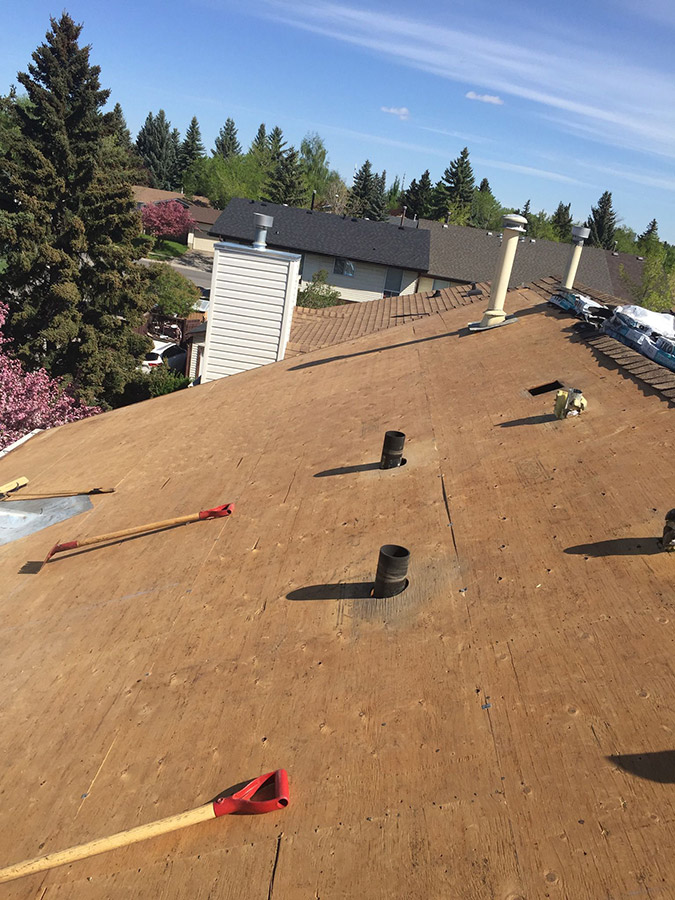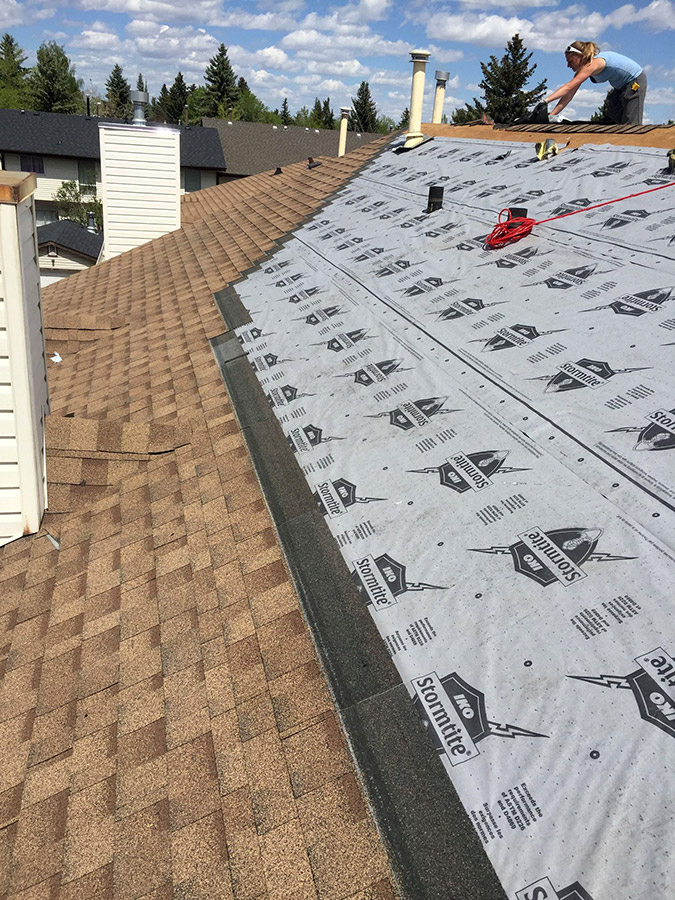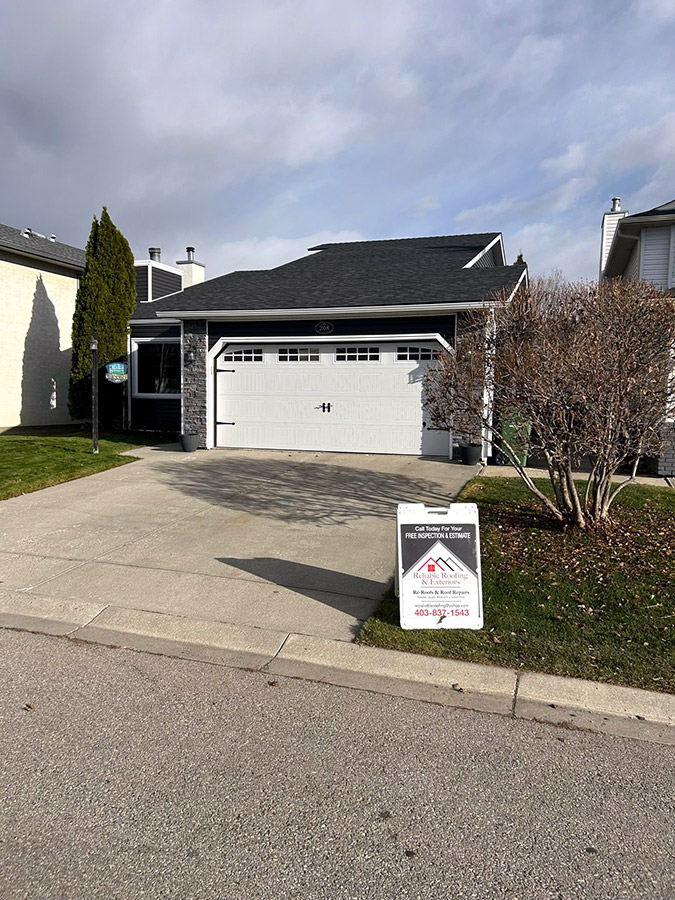Does my roof need need new shingles? How can I tell?
Inspecting your roof for signs of wear and tear is important in determining if you need new shingles. Here are some indicators to look out for:



- Age of the Roof: If your roof is approaching 20 years old, it’s advisable to inspect it more frequently as shingles tend to deteriorate with age.
- Bare Spots on Shingles: If you notice areas where the granules are missing, it could be a sign that the shingles are nearing the end of their lifespan.
- Curling or Buckling Shingles: Shingles that are curling at the edges or buckling in the middle indicate that they are past their prime and may need to be replaced.
- Cracked Shingles: Cracks in the shingles can lead to leaks and should be addressed promptly.
- Missing Shingles: If there are shingles missing from your roof, it’s a clear sign that they need to be replaced.
- Granules in the Gutters: Finding an excessive amount of granules in the gutters is a sign that the shingles are deteriorating.
- Sagging Roof Deck: A sagging roof deck could indicate moisture damage, signaling the need for a professional inspection and potentially new shingles.
Next Step
If you observe any of these signs, contact us for a free roofing quote to assess the condition of your roof and determine if new shingles are necessary. Regular maintenance and timely replacement of shingles can help extend the lifespan of your roof and prevent potential water damage.
If you are looking for roofing jobs in Calgary then check out calgaryconstructionjobs.com.
How long does reshingling a roof take?
- Small to Medium-Sized Roof: For a typical small to medium-sized roof, reshingling can take anywhere from one to two days to complete, assuming favorable weather conditions and no significant complications.
- Larger or More Complex Roof: Larger or more complex roofs may require two to three days to reshingle, especially if there are multiple layers of old shingles to remove or if the roof has intricate architectural features.
Does someone need to be home when you shingle my roof?
No one needs to be home but it’s always a good idea to be home once the roofing job is completed. Once the job is finished we can to a review of the work and clean-up.
Are there any extra costs aside from my estimate I should know?
Here are a few potential extra costs. This list also serves as an inspection checklist on the quote but please know, there are some things we can not possibly know until the old shingles are removed from your roof. We will, however, notify you of this before we proceed with any extra work.
(a) If we discover damaged or rotted wood decking during the removal of the old shingles, it may need to be replaced. This additional work can incur extra costs.
(b) If the fascia or soffit boards are found to be damaged or rotted, they may need to be repaired or replaced, resulting in supplementary expenses.
(c) Unforeseen structural issues, such as damage to the roof trusses or rafters, could necessitate repairs and lead to additional costs.
(d) Watch this news article on attic rain in Calgary. Upgrading or adding ventilation components to improve the airflow in the attic may be recommended, resulting in extra expenses.
Should all the components on my roof be replaced?
In a reshingling job, we replace the underlayment and shingles (and nails of course). Depending on the initial quote and what we see after the shingles are removed we may need to replace:
Flashing: Damaged or deteriorated flashing around chimneys, skylights, and roof valleys should be replaced to prevent water leaks and ensure proper waterproofing.
Ventilation Components: Upgrading or replacing ventilation components, such as ridge vents or soffit vents, may be necessary to improve airflow and maintain proper ventilation in the attic space.
If you have ice buildup in your attic then we could recommend improved ventilation to help the air flow.
Are open or closed valleys better?
The choice between open and closed valleys in roofing is often a matter of preference, aesthetics, and regional building practices. Both open and closed valley systems have their advantages, and the decision may depend on the architectural style of the home and individual homeowner preferences.
Open Valleys
Advantages:
Aesthetic Appeal: Open valleys can create a visually striking effect, as the metal or other valley material is exposed, adding a decorative element to the roof.
Ease of Maintenance: Open valleys can be easier to inspect and maintain due to their exposed nature, allowing for easier detection of debris buildup or potential issues.
Considerations:
Snow and Debris Accumulation: Open valleys may be more prone to the accumulation of snow and debris, which could potentially affect their performance if not properly maintained.
Closed Valleys
Advantages:
Weather Resistance: Closed valleys provide a more enclosed, protected channel for water runoff, which may enhance weather resistance and provide additional protection
against snow and debris buildup.
Versatility: Closed valleys can be constructed using a variety of materials, including shingles, metal, or specialized valley lining products, offering flexibility in design and functionality.
Considerations:
Aesthetics: Some homeowners may prefer the cleaner, more concealed look of closed valleys, while others may find them less visually appealing compared to open valleys.
Do I need Drip Edge and Ice & Water Shield?
Using drip edge and ice and water shield in roofing can provide important benefits for the long-term performance and protection of your roof. Here’s a breakdown of their purposes and advantages:
Drip Edge
Drip edge is a metal flashing installed at the edges of the roof to direct water away from the fascia and prevent it from seeping under the shingles.
- Water Management: Drip edge helps manage water runoff, reducing the risk of water damage to the underlying roof structure and fascia boards.
- Enhanced Durability: It can contribute to the long-term durability of the roof by protecting vulnerable edges from water intrusion and decay.
Local Building Codes: Compliance with local building codes may require the installation of drip edge, making it an essential component in many roofing systems.
Ice and Water Shield
Ice and water shield is a self-adhering membrane installed along the eaves and in valleys to provide an additional layer of protection against water infiltration, particularly in areas prone to ice dams and heavy rain.
- Waterproofing: It serves as a waterproof barrier, offering added protection in vulnerable areas where water may penetrate under the shingles.
- Ice Dam Prevention: In regions with cold climates, ice and water shield can help prevent water backup caused by ice dams, reducing the risk of water damage to the roof and interior of the home.
Climate Considerations: In colder climates or areas with heavy rainfall, the use of ice and water shield is often recommended to mitigate the risk of water infiltration and ice dam formation.
What are the following roofing components? Goosenecks, Vents, Whirly Birds, Plumbing Boot.
Goosenecks
Goosenecks, also known as gooseneck vents or exhaust vents, are roof-mounted ventilation devices designed to expel air from the attic space. They typically have a curved or “gooseneck” shape to allow for the release of hot, stale air from the attic. Goosenecks help facilitate proper attic ventilation by allowing warm air to escape, reducing moisture buildup and heat accumulation in the attic.
Vents
Vents in the context of roofing may refer to various types of roof vents, including ridge vents, soffit vents, static vents, or gable vents. These vents are installed on the roof to promote air circulation and ventilation within the attic space. Roof vents serve to exhaust hot air and moisture from the attic, helping to regulate temperature and reduce the risk of moisture-related issues, such as mold and mildew growth.
Whirly Birds
Whirly birds, also known as turbine vents or roof turbines, are passive ventilation devices installed on the roof. They feature a series of vanes that spin as wind passes over them, creating suction to draw hot air out of the attic. Whirly birds function as passive exhaust vents, aiding in the removal of hot, stagnant air from the attic space. They help promote attic ventilation and can contribute to cooling the attic during warmer months.
Plumbing Boot
A plumbing boot, also referred to as a pipe boot or pipe flashing, is a waterproof flashing component installed around plumbing vent pipes that penetrate the roof. It is designed to create a watertight seal around the pipe penetration. The plumbing boot serves to protect the area around plumbing vent pipes from water intrusion, ensuring that the roof penetration remains watertight and preventing leaks around the pipe opening.
What are Ice Dams & How do I prevent this?
Ice dams are ridges of ice that form at the edge of a roof, preventing melting snow from properly draining off the roof. This can lead to water backing up behind the dam and potentially seeping under the shingles, causing damage to the roof, insulation, and interior spaces.
Causes of Ice Dams
- Temperature Variations: Variations in roof surface temperatures can cause snow to melt and refreeze at the roof’s edge, creating the conditions for ice dams to form.
- Inadequate Insulation: Insufficient insulation in the attic can lead to heat loss from the living spaces below, causing the roof to warm unevenly and contribute to snow melting and ice dam formation.
- Inadequate Ventilation: Poor attic ventilation can exacerbate temperature differentials on the roof, contributing to the conditions conducive to ice dam formation.
Prevention of Ice Dams
- Proper Insulation: Ensuring adequate attic insulation helps maintain consistent temperatures on the roof, minimizing the likelihood of uneven snow melting and ice dam formation.
- Attic Ventilation: Proper attic ventilation is crucial in regulating temperatures on the roof. Soffit vents, ridge vents, and other ventilation components can help maintain consistent airflow, reducing the risk of ice dams.
- Air Sealing: Addressing air leaks and sealing gaps in the attic can help prevent warm air from escaping into the attic space, further mitigating the potential for uneven snow melting.
- Roof Raking: Using a roof rake to carefully remove snow from the lower portion of the roof can help prevent excessive snow buildup, reducing the likelihood of ice dams forming.
- Ice and Water Shield: Installing an ice and water shield membrane along the eaves and in vulnerable areas can provide an additional layer of protection against water infiltration in the event of ice dam formation.
- Professional Assessment: Seeking a professional roofing or insulation contractor to assess and address specific insulation, ventilation, and air sealing needs can help prevent ice dams and improve the overall energy efficiency of the home.
Do I need roof ventilation?
Yes, roof ventilation is essential for maintaining the overall health and longevity of your roofing system. Proper ventilation helps regulate temperature and moisture levels in the attic space, offering several benefits for the home and the roof structure.
Roof Ventilation Improves:
- Moisture Control: Effective ventilation helps prevent the buildup of excess moisture in the attic, reducing the risk of mold, mildew, and rot that can compromise the structural integrity of the roof.
- Temperature Regulation: Ventilation helps regulate attic temperatures, preventing excessive heat buildup in the summer and reducing the likelihood of uneven snow melting and ice dam formation in the winter.
- Energy Efficiency: Proper ventilation can contribute to improved energy efficiency by reducing the strain on heating and cooling systems, promoting a more comfortable indoor environment, and potentially lowering energy costs.
- Extended Roof Lifespan: By minimizing temperature extremes and moisture-related issues, adequate ventilation can help prolong the lifespan of roofing materials, reducing the need for premature repairs or replacements.
Types of Roof Ventilation
- Ridge Vents: Installed along the peak of the roof, ridge vents provide continuous ventilation, allowing hot air to escape from the attic while drawing in fresh air through soffit vents.
- Soffit Vents: Positioned along the eaves of the roof, soffit vents facilitate the intake of fresh air into the attic, working in conjunction with ridge vents to promote airflow.
- Gable Vents: Gable vents are installed in the gable ends of the attic and contribute to ventilation by allowing air to enter and exit the attic space.
- Static Vents: These non-mechanical vents are available in various styles, such as roof louvers or roof turbines, and provide passive ventilation by allowing hot air to escape from the attic.
It’s important to have a professional roofing contractor assess your specific ventilation needs based on the size and design of your home, local climate considerations, and the condition of your existing ventilation system. A professional can recommend the most suitable ventilation solution to ensure optimal performance and the long-term health of your roofing system.
By ensuring proper roof ventilation, homeowners can safeguard their homes against potential issues related to moisture buildup, temperature extremes, and energy inefficiency, ultimately contributing to the overall well-being of the structure.
What are the signs of a leaking roof?
Several signs can indicate a leaking roof in a house. These signs include:
- Water Stains on the Ceiling or Walls – water stains or discoloration on the ceiling or walls, especially after heavy rain, can indicate a roof leak.
- Dripping Water or water trickling down the walls, particularly during or after rain, is a clear indication of a roof leak.
- Missing, cracked, or damaged shingles can create openings for water to seep into the roof structure, leading to leaks.
- Curling or buckling shingles can allow water to penetrate the roof, causing leaks and water damage.
- Accumulation of granules from the shingles in the gutters is a sign of deteriorating roofing materials, which can lead to roof leaks.
- Presence of mold or mildew in the attic or on the upper walls can be an indication of moisture infiltration from a leaking roof.
- A sagging ceiling can be a result of prolonged water damage from a roof leak and should be addressed immediately.
- Peeling or bubbling paint or wallpaper on the walls or ceiling can be due to water damage caused by a leaking roof.
- Musty or damp odors in the attic or upper floors of the house can indicate hidden water damage from a roof leak.
If you notice any of these signs, it’s important to promptly address the issue by contacting a professional roofing contractor to inspect and repair the roof to prevent further damage to the property.
